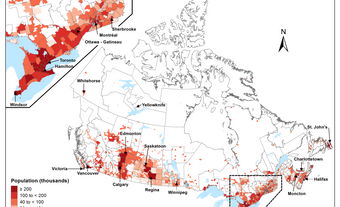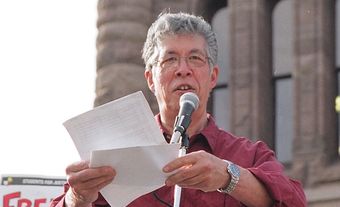Guelph, Ontario, incorporated as a city in 1879, population 143,740 (2021 census), 131,794 (2016 census). The City of Guelph, the seat of Wellington County, is located on the Speed River in south central Ontario, 96 km west of Toronto and 28 km east of Kitchener-Waterloo. This industrial and educational centre is set in the heart of a highly productive agricultural region.
Settlement
Indigenous Peoples
Archaeological evidence shows that First Nations peoples used the site of present-day Guelph as early as 11,000 to 10,300 years ago. Later, the Chonnonton, or Neutral, peoples inhabited a large part of southern Ontario, including what is now Guelph. Archaeological evidence also suggests that although the Chonnonton had expanded into the area of present-day London in the 1300s, by the 1400s their settlements were concentrated mostly east of the Grand River, mostly within a 32 km radius of present-day Hamilton, Ontario. European intrusion and diseases exacerbated intertribal warfare. Between 1647 and 1651, the Haudenosaunee (Iroquois) dispersed the Chonnonton. After 1690 the Mississauga (see Ojibwa) entered the area from north of Georgian Bay, settling along major tributaries of Lake Ontario and Lake Erie. In 1784, the British, facing an influx of settlers in the wake of the American Revolution, negotiated with the Mississaugas to purchase a huge tract of land, including the location of present-day Guelph, for approximately £1,180.
European Settlement
John Galt founded Guelph as a planned town in 1827. Galt was a Scottish novelist and the superintendent of the Canada Company, a land company based in London, England. Galt adopted the concept of planning towns in advance of general settlement in order to stimulate sales of agricultural land. He laid out an imaginative town plan, with streets radiating from a focal point, a design based on American precedents such as Buffalo, New York. The original layout is still discernible in the present business core. Galt chose the town's name to honour Britain's royal family, the Hanoverians, who were descended from the Guelfs, one of the great political factions in late medieval Germany and Italy. Guelph was first incorporated as a village in 1851 and incorporated as a town soon after in 1856.

Development
Shops and hotels gradually appeared around the triangular market grounds at the town’s centre bordered roughly by Carden, Wilson and Surrey Streets. During the 19th century the water power potential at the town site attracted a number of large mills, and entrepreneurs William Allan and James Goldie owned the most important ones. Beginning in the 1860s, several local industries established a worldwide reputation based on technological innovation. These included the Raymond Sewing Machine Co and the W. Bell and Co organ company, which at its peak in 1885 manufactured 5,000 to 6,000 organs and pianos per year.
By 1900, The People’s Flour Mills, operated by James Goldie and his sons, was the only significant mill remaining in Guelph (see Flour Milling). However, the early 20th century was a time of industrial growth for the town (see Industry in Canada). Previously existing companies such as the Royal Knitting Co and the Bell Piano & Organ Co expanded, accounting for a large percentage of the town’s industrial growth. Some new industries also appeared in the early 1900s, such as the Canada Ingot Iron Company (later named Armtec).
The brewing industry also expanded in the early 20th century. In 1851 John H. Sleeman established the Silver Creek Brewery. His son, George Sleeman expanded the family’s brewing business and founded the Spring Bank Brewery, eventually consolidating the businesses under Sleeman Brewing and Malting Co. In 1933, John H. Sleeman’s grandsons, were charged with smuggling alcohol to the United States and failing to pay taxes — something the company became involved in during the American prohibition. (See also Prohibition in Canada.) The family’s brewing license was suspended and the brewery would not open again until the 1980s. (See Economy and Labour Force, below.)
Cityscape
Much of the city's 19th-century townscape still exists. The wide use of a locally quarried limestone that could easily be worked by stone carvers has given much of the community a visual unity. This is especially evident on major downtown streets such as Wyndham, where architects used almost continuous cornice heights and consistent window spacings throughout neighbouring buildings. Particularly significant structures include the Renaissance Revival-style City Hall (1856-57), designed by William Thomas, and Joseph Connolly's Church of Our Lady Immaculate (1876–88), which was designated a minor basilica in 2014.
Population
The population of Guelph has always been highly British in ethnic origin. Early on, residents of the town were overwhelmingly of English background, making up 92 per cent of the population in 1880, and 87 per cent in 1921. More recently, in the 2021 census, the most commonly cited ethnic origin was English, accounting for 23.4 per cent of the population, followed by Scottish (20.6 per cent), Irish (19.5 per cent), Canadian (13.3 per cent), German (11.1 per cent) and Italian (8.6 per cent). Visible minorities make up 25.3 per cent of Guelph’s population, with South Asian, Chinese, Black and Filipino people comprising the largest communities.
Economy and Labour Force
The economic base of the community has continued to be manufacturing, which employs approximately 18 per cent of the local workforce. Leading employers in this sector are Linamar Corporation and Polycon Industries, and Guelph is home to many companies focusing on fabricated metal, machinery and transportation equipment manufacturing. In 1988, John W. Sleeman (John H. Sleeman’s great-great grandson) re-established the family’s old brewing business, which had gone dormant. In 2006, Sleeman Breweries was sold to Sapporo, a Japanese company, which has kept the brewery in Guelph. (See also Brewing Industry in Canada.)
Transportation
Under the leadership of John Galt, by 1828 workers had cleared roads to Waterloo, Eramosa and Goderich. The Grand Trunk Railway arrived in Guelph in 1856, linking it to Montreal and other industrial centres. Many business owners felt that the Grand Trunk’s rates were too high; and, after four years of construction, the Guelph Junction Railway (linking the city to the Canadian Pacific Railway) was completed in 1888.
George Sleeman, a local businessman and member of the Sleeman family of brewers, began Guelph’s public transit system in 1895 when he paid for the creation of the Guelph Railway Company. This company ran streetcars on five miles of track, including some along Waterloo Avenue and present-day Woolwich Street. By the early 1900s, the Guelph Railway Co was struggling and Sleeman lost the company. In 1905, the city purchased the re-named Guelph Radial Railway. Ontario Hydro operated the streetcars beginning in 1919, but the increasing use of cars and trucks, and the financial hardship of the Depression years, led to the Guelph streetcars’ eventual disappearance in 1937.
Guelph’s road network grew quickly after the First World War, and provincial highways 6, 7 and 24 passed through the city (see Roads and Highways). The Hanlon parkway was built in 1972 to connect Guelph to Highway 401. Today, the transportation network in Guelph also includes Guelph Transit city buses, GO Transit trains and buses, and VIA Rail Canada trains.
Communications
Guelph has a rich tradition of print news. Guelph’s first newspapers were the Guelph Herald, first published in 1842, and The Wellingtonian, which appeared in 1843. Both newspapers were short-lived. The Guelph Mercury was established in 1867, the year of Canada’s Confederation, making it one of the country’s oldest newspapers. The Advertiser appeared in 1844, while the Wellington Mercury was founded in 1853, and another newspaper, The Advocate, was established in the 1890s. At the end of the 20th century, the Guelph Mercury survived as the city’s sole daily, while the Guelph Tribune was published twice per week. In 1999, the Mercury merged with the Cambridge Reporter and the Kitchener-Waterloo Record into Torstar’s Grand River Valley Newspapers. As the national media landscape continued to shift and change into the 21st century, the Mercury, like many newspapers, struggled financially. On 29 January 2016, after 149 years in print, the paper ceased publication. The Tribune, renamed The Guelph Mercury Tribune, publishes once weekly as well as online.
Guelph’s first radio station, CJOY, appeared in 1949, broadcasting a variety show from the Capitol Theatre. CJOY continues to broadcast today and has been joined in the city by the non-profit CFRU radio, which offers a wide variety of local programming. The station began broadcasting in 1980 and is based at the University of Guelph.
Guelph is also home to a local television channel, Rogers Cable 20. In December 1952 Fred Metcalf, a pioneer of cable television, established Neighborhood Television Limited in Guelph. In 1968, Metcalf sold the company to Maclean-Hunter; and Rogers TVtook it over in 1994, which led to the creation of Rogers Cable 20. (See also Radio and Television Broadcasting.)
Government and Politics
Between 1856 and 1879 Guelph was led by a mayor and 12 aldermen who were chosen each year in ward elections. After 1880 the number of alderman grew to 18, but in 1903 the electorate chose to change to an at-large system (meaning that the whole municipality began to vote for the aldermen, as opposed to each candidate representing a different ward or portion of the city). Over the following decades the local electoral system saw many changes, with the number of aldermen ranging from 11 to 18. By 1930 the town had settled on 11 aldermen and a mayor. Representatives were initially elected yearly, but in 1966, two year terms were introduced, and three year terms were adopted after 1983. In 1992, residents voted in a plebiscite to return to the ward system. As of 2006, the city’s mayor and councillors serve a four-year term in office. In 2021, the boundaries for Guelph’s six wards were adjusted. The six wards are led by a mayor and councillors, two elected from each ward.
The 2000 election was of particular note. In it, residents elected Karen Farbridge as mayor, joining MP Brenda Chamberlain and MPP Brenda Elliot to make Guelph the first city in Canada where women led all three levels of government.
Cultural Life
The city and district have been home to a number of well-known artists, such as Ken Danby and Thomas King. Major support for artistic activity is provided by the Art Gallery of Guelph on the University of Guelph campus, while the River Run Centre provides a venue for music and theatre. Additionally, the Sleeman Centre seats 4,500 and hosts sports events, trade shows, and concerts. Guelph's cultural heritage, however, is primarily musical. Edward Johnson (1878–1959), the world-famous operatic tenor and manager of New York's Metropolitan Opera, was born and educated in the city. The highly acclaimed Guelph Spring Festival is a two-week presentation of concerts, operas, films and plays. Other annual musical events include the Kiwanis Music Festival, Guelph Jazz Festival and Hillside Festival. Guelph is also home to several sports teams, notably the OHL Guelph Storm hockey franchise.
The house where John McCrae, the author of the poem “In Flanders Fields,” was born is now a national historic site and has been converted into a museum. Guelph Civic Museum traces the development of Guelph since the city's founding. In 2012, the museum relocated to the newly renovated Sisters of Loretto Convent near the Basilica of Our Lady Immaculate.
The city is host to the University of Guelph. It was established in 1964, but the university represents an amalgamation of several colleges whose traditions go back more than a century. The Ontario Agricultural College was founded in 1874 on a 200 hectare experimental farm south of the town site (see Agricultural Education). It has been an important force in agricultural research throughout the world. Among its noted graduates is the economist John Kenneth Galbraith.

At the instigation of Adelaide Hoodless, a second college, the Macdonald Institute, was built in 1903 to teach household science (see Home Economics). In 1922, the Ontario Veterinary College was moved to the Guelph campus. The present university's research has won international recognition in a wide variety of fields, especially for helping to solve the complex agricultural problems of developing countries.

 Share on Facebook
Share on Facebook Share on X
Share on X Share by Email
Share by Email Share on Google Classroom
Share on Google Classroom












